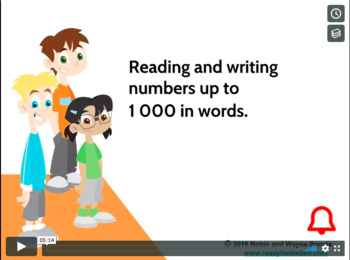Grade 3: Math: Whole Year Concept Instructional Video Bundle
- Zip
Products in this Bundle (10)
showing 1-5 of 10 products
Description
Ready for the Bell math resources provide a comprehensive set of print, multimedia resources, and assessments with a real world learning explorations.
A Concept Instructional Video is a combination of a PowerPoint slide deck with teacher notes for you or your parents to present PLUS a video with audio explaining the concept. These mini-lessons break a concept down into more detail and provide the students with a variety of learning strategies to use as they work to understand and be able to apply the concept in real life. Concept Instructional Videos can be used in three ways:
• To teach a concept that comes from a previous grade curriculum and is needed for the Lesson in the present grade curriculum
• To reinforce a concept that was taught in the present grade curriculum but where more practice or a different approach may be useful
•To extend a concept beyond the present grade curriculum
Students view the Concept Instructional Video as a start stop video.
Teachers receive PPT and Google Slide versions of the Concept Instructional Video complete with speaking notes.
This Concept Instructional Video includes:
- 10 Concept Instructional Video
- 10 Concept Instructional Video Powerpoints
- 10 Concept Instructional Video Notes
This Concept Instructional Video is part of the Math 3 lesson bundles. Click below to see these bundles.
Unit Packet: Place Value, Rounding, Addition and Subtraction
Unit Packet: Multiplication and Division
Unit Packet: Area and Measurement
Common Core Alignment
Use place value understanding to round whole numbers to the nearest 10 or 100.
Fluently add and subtract within 1000 using strategies and algorithms based on place value, properties of operations, and/or the relationship between addition and subtraction.
Solve two-step word problems using the four operations. Represent these problems using equations with a letter standing for the unknown quantity. Assess the reasonableness of answers using mental computation and estimation strategies including rounding.
Interpret products of whole numbers, e.g., interpret 5 × 7 as the total number of objects in 5 groups of 7 objects each. For example, describe a context in which a total number of objects can be expressed as 5 × 7.
CCSS.MATH.CONTENT.3.OA.A.2
Interpret whole-number quotients of whole numbers, e.g., interpret 56 ÷ 8 as the number of objects in each share when 56 objects are partitioned equally into 8 shares, or as a number of shares when 56 objects are partitioned into equal shares of 8 objects each. For example, describe a context in which a number of shares or a number of groups can be expressed as 56 ÷ 8.
CCSS.MATH.CONTENT.3.OA.A.3
Use multiplication and division within 100 to solve word problems in situations involving equal groups, arrays, and measurement quantities, e.g., by using drawings and equations with a symbol for the unknown number to represent the problem.1
Fluently multiply and divide within 100, using strategies such as the relationship between multiplication and division (e.g., knowing that 8 × 5 = 40, one knows 40 ÷ 5 = 8) or properties of operations. By the end of Grade 3, know from memory all products of two one-digit numbers.
Multiply one-digit whole numbers by multiples of 10 in the range 10-90 (e.g., 9 × 80, 5 × 60) using strategies based on place value and properties of operations.
Tell and write time to the nearest minute and measure time intervals in minutes. Solve word problems involving addition and subtraction of time intervals in minutes, e.g., by representing the problem on a number line diagram.
CCSS.MATH.CONTENT.3.MD.C.5.A
A square with side length 1 unit, called "a unit square," is said to have "one square unit" of area, and can be used to measure area.
CCSS.MATH.CONTENT.3.MD.C.5.B
A plane figure which can be covered without gaps or overlaps by n unit squares is said to have an area of n square units.
CCSS.MATH.CONTENT.3.MD.C.6
Measure areas by counting unit squares (square cm, square m, square in, square ft, and improvised units).
CCSS.MATH.CONTENT.3.MD.C.7.A
Find the area of a rectangle with whole-number side lengths by tiling it, and show that the area is the same as would be found by multiplying the side lengths.
CCSS.MATH.CONTENT.3.MD.C.7.B
Multiply side lengths to find areas of rectangles with whole-number side lengths in the context of solving real world and mathematical problems, and represent whole-number products as rectangular areas in mathematical reasoning.
CCSS.MATH.CONTENT.3.MD.B.3
Draw a scaled picture graph and a scaled bar graph to represent a data set with several categories. Solve one- and two-step "how many more" and "how many less" problems using information presented in scaled bar graphs. For example, draw a bar graph in which each square in the bar graph might represent 5 pets.
CCSS.MATH.CONTENT.3.MD.B.4
Generate measurement data by measuring lengths using rulers marked with halves and fourths of an inch. Show the data by making a line plot, where the horizontal scale is marked off in appropriate units— whole numbers, halves, or quarters.





